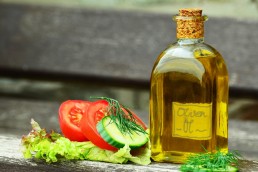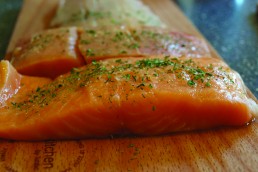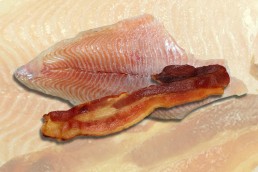Nuke them Fishy Fillets, Mediterranean-Style
SHARE THIS POST
Mediterranean countries have people who typically consume as high number of vegetables, olive oil and a moderate amount of protein. This diet is considered very healthy. I’ve known people who take a dose of olive oil like taking a vitamin in the morning. One lady swore to the restorative properties of a tablespoon of olive oil and a tablespoon of vinegar with breakfast. Olive oil and vinegar make a splendid salad dressing. Maybe she would have been healthier had she added a handful of lettuce and tomato.
The oils associated with a Mediterranean diet was popularized since the 1950s in North America for its health benefits. The olive is one of the three core food plants in Mediterranean cuisine; the others are wheat and grapes.
Olive trees have been grown around that region for over 10 millennia. Spain is the largest producer of olive oil followed by Italy and Greece. Per capita, consumption is the highest in Greece, followed by Spain, Italy and Morocco. North America and northern Europe uses it less, but it is steadily growing.
Here’s the rub: What’s a good olive oil? International Olive Council (IOC) is an intergovernmental organization of countries that produce olives or products derived from olives. The IOC officially governs 95 percent of international production and holds influence over the rest.
The U.S. is not a member of the IOC, however, in 2010 the U.S. Department of Agriculture adopted new voluntary olive oil- grading standards that closely parallel those of the IOC. Yet most major U.S. brands continue to put “Imported from Italy” on their front labels in large letters and the other origins on the back label in small print. In fact, olive oil labeled “Italian” often comes from Turkey, Tunisia, Morocco, Spain and Greece.
But what percentage of the oil really came from Italy?
Why make things simple when you can create enough confusion that customers throw up their hands in frustration and select their olive oil through the old-fashioned technique of eeney, meeney, miney, mo.
The grades of oil can be classified as “Virgin,” meaning the oil was produced by mechanical means only with no chemical treatment. Grades, in order down from the best of virgin olive oil, include “Extra Virgin,” “Virgin,” “Ordinary Virgin” and “Lampante Virgin.”
TIP: The best time to buy olive oil is just as the new season hits the markets in early winter.
Microwaved Mediterranean-style Crappies
6 individual 2-ounce skinless slab fillets
1/2 pound green beans, trimmed
1/2 pint cherry tomatoes
1 ounce pitted Kalamata olives, thinly sliced (about 3 tablespoons)
2 garlic cloves, very finely chopped
2 tablespoons dry white wine
1 tablespoon olive oil
3/4 teaspoon kosher salt, divided
1/4 teaspoon freshly ground black pepper, divided
4 sprigs thyme
In an 8-by-8-inch microwave-proof baking dish, toss green beans, tomatoes, and olives with garlic, wine, oil, 1/4 teaspoon salt and 1/8 teaspoon pepper. Cover with plastic wrap. Poke a small hole in the center and microwave on high 3 minutes. Remove from microwave, uncover and stir.
Are you enjoying this post?
You can be among the first to get the latest info on where to go, what to use and how to use it!
Season fish on both sides with remaining 1/2 teaspoon salt and 1/8 teaspoon pepper. Arrange over green bean mixture in baking dish. Top each fillet with thyme sprig.
Cover with plastic wrap and microwave on high for 2 1/2 minutes. Check to see if fish is opaque. If it is not, continue microwaving them at 20-second intervals. Remove from microwave and let sit covered for 2 minutes.
Mediterranean-style Fish Sandwiches
In keeping with the healthy Mediterranean diet with fish, let’s whip up some fancy sandwiches topped with slaw.
Slaw:
4 1/2 teaspoons fresh lemon juice
4 1/2 teaspoons fresh lime juice
1 tablespoon hot sauce
1 tablespoon olive oil
1/2 teaspoon dried oregano
1/2 teaspoon kosher salt
1/2 medium white onion, thinly sliced
1 large jalapeño, thinly sliced, seeds removed
1/2 medium poblano chili, thinly sliced with seeds removed
Combine lemon and lime juice, hot sauce, olive oil, oregano and salt in a large bowl. Add onion, jalapeño and poblano chili and toss to combine. Marinate at least 30 minutes or up to 1 hour. Slaw can be made, strained and refrigerated up to 1 day ahead.
Tartar sauce:
6–7 cornichons, thinly sliced into
1/4-inch coins (pickled French gherkins)
1/2 cup mayonnaise
1/4 cup coarsely chopped fresh parsley
3 teaspoons coarsely chopped capers
2 teaspoons tomato powder (optional)
1 1/2 teaspoons distilled white vinegar
Large pinch chili powder
Large pinch kosher salt
Combine cornichons, mayonnaise, parsley, capers, tomato powder (optional), vinegar, chili powder and salt in a small bowl. Tartar sauce can be made and refrigerated up to 2 days ahead.
Fish:
8 skinless slab fillets, (2 ounces per fillet)
1 cup all-purpose flour
1 cup cornstarch
3 teaspoons dried oregano
2 teaspoons onion powder
2 teaspoons tomato powder (optional)
1 teaspoon garlic powder
3 teaspoons kosher salt, plus more
1 1/2 cups club soda
Canola oil (for frying)
4 sesame seed potato buns, split, toasted
8 slices ripe tomato
Whisk flour, cornstarch, oregano, onion powder, tomato powder (optional), garlic powder and 3 teaspoons salt in a large bowl. Add club soda and quickly whisk to incorporate. Pour canola oil into a large skillet to a depth of 1/4 inch. Heat oil to 350 degrees (medium high) until hot. Dip fish into the batter to coat and shake off excess. Fry until golden and crispy and cooked through, about 3-4 minutes per side. Work in batches if necessary and adjust the heat as needed to keep oil at 350 degrees. Drain on paper towels and season with salt.
The sandwiches:
Strain the slaw and discard the liquid. Spread 1 tablespoon of tartar sauce on top and bottom of buns. Place tomato slices on bottom halves and top with fried fish and slaw. Add top halves to buns.
MWO
SHARE THIS POST
Did you enjoy this post?
You can be among the first to get the latest info on where to go, what to use and how to use it!
Vernon Summerlin
For more than 30 years, Vernon Summerlin has produced outdoor articles and books that can be found on Amazon; most recently How to Analyze a Bass Hole: Think and Catch’em! He is the recipient of more than 40 awards for magazine and newspaper articles, TV, radio, photography and books.



